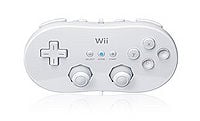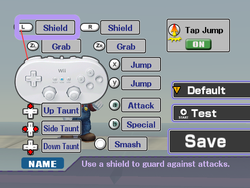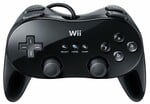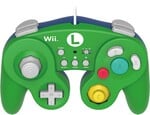Classic Controller: Difference between revisions
| Line 15: | Line 15: | ||
==Standard Controls== | ==Standard Controls== | ||
[[File:DefaultClassicSSBB.png|thumb|right|250px|Classic Controller controls menu in ''Brawl''.]] | |||
[[File:DefaultClassicSSB4.jpg|thumb|right|250px|Classic Controller controls menu in ''For Wii U''.]] | |||
===''Super Smash Bros. Brawl'' and ''Super Smash Bros. for Wii U''=== | ===''Super Smash Bros. Brawl'' and ''Super Smash Bros. for Wii U''=== | ||
{|class="wikitable" style="text-align:center" | {|class="wikitable" style="text-align:center" | ||
Revision as of 19:55, June 4, 2024
During E3 2006, Nintendo introduced the Classic Controller, which plugs into the Wii Remote via a cord in a similar fashion as the Nunchuk. The overall configuration is similar to that of other major seventh generation console controllers, and is also particularly similar to the SNES controller.
The Classic Controller features two analog sticks, a D-pad, a, b, x and y buttons, the L and R shoulder buttons, and two Z buttons (labeled ZL and ZR) next to the L and R buttons, respectively. It also has a set of -, Home, and + buttons like those on the Wii Remote.
Compatibility
In Super Smash Bros. Brawl, the Classic Controller can be used as a viable control scheme through the method of plugging it into the Wii Remote. The Classic Controller can also be used for Super Smash Bros. on Virtual Console.
The Wii Remote returned as a compatible controller for the Wii U, meaning the Classic Controller is also compatible by extension, and both were made compatible with Super Smash Bros. for Wii U. However, The Wii Remote was not made compatible with the Nintendo Switch, meaning it and the Classic Controller by extension are not compatible with Super Smash Bros. Ultimate.
In Brawl and For Wii U, the buttons on the Classic controller can be remapped in the Controls menu to perform other functions.
Standard Controls
Super Smash Bros. Brawl and Super Smash Bros. for Wii U
| Move | |
| Standard attacks | |
| Special moves | |
| Stick-smash | |
| Jump | |
| Grab | |
| Shield | |
| Taunt | |
| Pause | |
| Home Menu | |
| Nothing |
Super Smash Bros.
| Control | N64 equivalent | Action |
|---|---|---|
| Move | ||
| Standard attacks | ||
| Special moves | ||
| Jump | ||
| Grab | ||
| Shield | ||
| Taunt | ||
| Pause | ||
| Nothing | Home Menu/Operations guide | |
| Nothing | Move (menu only) |
Technical data
Licensed Variants
Classic Controller Pro
Released in 2009 and plugs into the Wii Remote the same as its predecessor. Features a design overhaul with a new wing thigh grip design and the ZL and ZR buttons relocated behind the L and R buttons as secondary shoulder buttons, in the vein of the Z button on the GameCube controller. As it was released after Brawl, the game makes no reference to the new model; all images show the original Classic Controller. However, the Classic Controller Pro is used in images in For Wii U instead of the original.
Wired Fight Pad
Released in November 2014 by 3rd party controller manufacturer PDP. Has the internal components of a Classic Controller, but with an outer shell reminiscant of a GameCube Controller. Owing to its design and release date, some players presume that it is targeted primarily towards Smash Bros. players.[1]
Hori Battle Pad
Released in November 2014 by 3rd party controller manufacturer Hori. Has the internal components of a Classic Controller, but with an outer shell reminiscant of a GameCube Controller. Generally considered preferable to the Wired Fight Pad due to the closer resemblance to a GameCube controller and overall better build quality.
In competitive play
Although the GameCube controller was competitive Brawl's most popular controller option, the Classic Controller, specifically the Classic Controller Pro, was significantly popular as well. Its ease of access at the time of release as well as being shaped the most like an industry standard controller made it attractive to new players. Derivatives like the Hori Battle Pad were also relatively popular due to being directly modeled after a GameCube controller. The Virtual Console release of Super Smash Bros. also enticed Smash 64 players that skipped Melee to use the controller by bridging the gap between the games.
Despite also being available with Super Smash Bros. for Wii U, its direct successor, the Wii U Pro Controller, being compatible with the same game, made it quickly fall out of favor and become a rarity in tournaments for that game.
References
| Controllers and buttons | |
|---|---|
| Nintendo 64 controller | |
| GameCube controller | |
| Wii Remote (and Nunchuk) | |
| Classic Controller | L |
| Nintendo 3DS | |
| Wii U GamePad / Pro Controller | L |
| Joy-Con | |
| Switch Pro Controller | L |
| Third-party controllers | Hori Mini Pad · Arcade controller · Keyboard |
| Other | Smash Controller · Controller modification |






